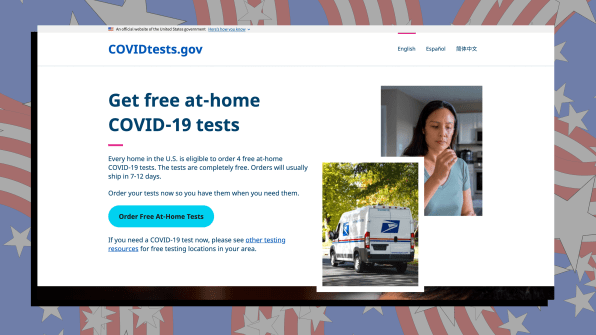People are used to terrible government websites. COVIDtests.gov is an exception
Last month, the Biden administration announced it would be making four at-home COVID-19 tests available to every American household via a new government website, COVIDtests.gov. Today nearly half of adults across the country report having used the site, which has received unusually high praise for a government website. Scheduled to launch on Wednesday, January 19, the site went live a day early.
As veterans of large-scale government rollouts like Healthcare.gov and advocates of public interest technology, we know that marquee initiatives and critical rollouts live and die by the strategies and collaboration (or lack thereof) that help guide their creation and execution. The rollout of COVIDtests.gov, while not perfect, could herald a new era of digital infrastructure at the federal level. The Biden administration has now had two successful digital rollouts—before COVIDTests.gov, there was Vaccines.gov, which provided a centralized database so that those without access to doctors or insurance could find vaccination sites. It seems that there is a solid understanding, finally, of what’s needed to make digital policy implementation a reality.

COVIDtests.gov is not a one-off. It’s the result of 10 years of executive branch learning that came after the much-maligned launch of Healthcare.gov, six years of learning from the U.S. Digital Service (USDS), and a transition team that prioritized digital service optimization that would help the administration respond more effectively to challenges like COVID-19. Since assuming office, President Joe Biden’s administration has been engaging in collaborative technological projects that are a stark departure from top-down, bureaucratic endeavors of the past. There are also numerous veterans of service delivery in government and new efforts underway to bring in more early-career technologists.
The collaborative approach between the Biden White House, the U.S. Postal Service, the Department of Health and Human Services (HHS), and USDS was especially significant with COVIDtests.gov. The choice to work hand in hand with USPS as part of an interagency effort—instead of designing the initiative for an agency and charging it with overseeing its execution and delivery—shows the administration understands that the best projects are designed with agencies, not for them. This is exactly the philosophy encouraged by public interest technology and its advocates, which we wrote about in Power to the Public.
For example, charging HHS with this project might have seemed a more natural fit, at least initially, because of its links to COVID-19 and public health. The administration knew, however, that the agency with the most accurate database of U.S. households (and their addresses) was the Postal Service. Given the importance of the project, and the timeline and scale of its rollout, however, it made far more sense to merge issue expertise with technical capacity and operational infrastructure.
The partnership is yet another indicator that this project was well thought out, and serves as a key sign of strategy growth and evolution. With Healthcare.gov, the White House relied exclusively on HHS, which had no existing technical experience or infrastructure in place. At the time, the U.S. Digital Service didn’t exist; it was created in 2014 to improve digital service, strengthen websites, and optimize the performance of digital products. There weren’t UX and digital experts in-house at HHS; instead, the team relied on more than two dozen companies building parts of the work without a central driving vision or manager—and execution suffered as a result.
COVIDtests.gov, meanwhile, has withstood the load of millions of Americans requesting tests for their households in its first week. That’s the result of years of research on what a site that serves all Americans should look like and how it should function. The team in charge of executing it worked through the holidays to get it ready, and told us that they were in charge of the timeline for rollout—a logical, yet very unusual, approach for a government project, which is typically top-down in the decision-making. They specifically chose to do a soft launch rather than a big rollout with fanfare, and the generally positive response is a direct result of learning from previous administrations’ mistakes.
The successful rollout of a collaborative project housed within the Postal Service is especially significant given concerns about its load capacity and reduced funding as recently as the 2020 election. That was followed by the immense pressure of staffing challenges, shipping costs, and supply chain disruptions over the past year. Amid praise in the press and on Twitter, the site did generate error messages for some users, which USPS identified as predominantly affecting a “small percentage” of multi-household dwellings. A myriad of how-to articles sprang up in response.
According to someone who was involved in the COVIDtests.gov project, the multi-household problem was primarily an issue of limited federal access to current information about how single-family-zoned housing units are broken down. For example, a house that might previously have been a single-family dwelling but has since been divided into four condos wouldn’t register as four separate homes if the USPS database hadn’t been updated to reflect that—or if property registrations and zoning changes hadn’t been properly filed or logged. Often mail continues to get delivered correctly because the delivery person notices the change, even though it might not be officially logged in the database.
In a small number of cases, there was a structural problem with apartment units being entered into the form in a way the database could not understand. For instance, entering “5000 ABC St., Apt. 306” might not trigger a match with a database record of “5000 ABC St., #306.” These are, of course, short-term challenges that, if left unchecked, could become long-term ones. If government databases are going to be used for future projects and usher in a new generation of digital services, they will need to be cleaned up.
These issues were minor, given the scope of the project. But even amid success, it’s important to maintain a sense of perspective, and—let’s be honest—COVIDtests.gov is a single-page form that worked well. That shouldn’t ordinarily be surprising or laudable.
It remains to be seen how seamlessly the tests will actually be delivered, and it’s another question entirely whether the number of tests—four per household—is actually sufficient for addressing the long-term challenges posed by COVID-19. We would argue, as have others, that it isn’t. Regardless, the general delight with this site’s rollout speaks to the low bar for government interaction; everyone expects government efforts to be bad because we tend to only hear about projects when they don’t work. If you aren’t someone who receives Supplemental Nutrition Assistance Program (SNAP) benefits or applied to become a citizen online, perhaps you haven’t interacted with government technical innovations or witnessed the evolution of civic technology.
If the eventual rollout of this effort is successful, it will serve as a useful proof point and case study for future efforts, and will certainly be a good, if small, first step in building back the public’s trust in government. There are already signs of meaningful change: The Biden administration announced a plan to improve customer service across the board in December through a new executive order. Ultimately, if the public is to trust that the government can work well, it will need to do so more of the time. That starts with the sort of participatory design we saw here.
Tara Dawson McGuinness is the founder and director of the New Practice Lab at New America. Hana Schank is a senior adviser for public interest technology at New America. In 2021 the pair released Power to the Public, a book about how governments can solve public problems in the digital age by working directly with communities.
(39)



